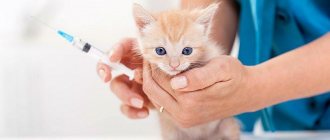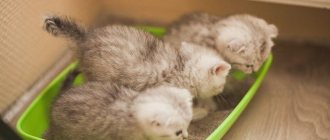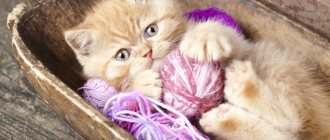Veterinarians strongly recommend sterilizing domestic cats in order to regulate their behavior and control the population. This especially applies to urban animals. Castration of a cat and sterilization are not the same thing. During castration, the gonads are removed entirely; during sterilization, the pathways of sperm in British males and the fallopian tubes in females are stopped. Both operations make it impossible for a British man or woman to reproduce.
The difference is that with complete removal of the reproductive organs, sex hormones cease to be produced, and the pet no longer strives to mate. After sterilization, sexual instincts continue to manifest themselves.
Procedure of castration, ovariohysterectomy
Castration of cats is carried out in order to stop the production of sex hormones until the reproductive instinct completely disappears. Castration can be done surgically or with medication. Surgery to remove testes from the scrotum or abdomen requires general anesthesia. The medical method consists of implanting a subcutaneous implant (Suprelorin) and is performed under local anesthesia. Both methods lead to the cessation of testosterone production, suppression of sexual instincts, and correction of the animal’s behavior.
For cats, castration (ovariohysterectomy) involves the removal of the internal genital organs: the uterus, ovaries, and fallopian tubes. The operation protects against uncontrolled mating and reduces the risk of reproductive cancers.
Photo - the genitourinary system of a cat
Why is castration (sterilization) necessary?
Why castrate? If a cat is constantly staying (living) in the enclosed area of a city apartment, the needs dictated by libido are a regular source of concern for the animal and the owners. The animal gets nervous, tries to mark its territory, and makes loud beeps at the most inopportune times of the day. If the cat is not intended to reproduce and cannot satisfy this natural need, castration is the only possible solution.
In a sterilized cat, the production of estrogen (the hormone of sexual activity) is blocked. This effect prevents the development of low-quality tumors of the mammary glands, uterus or ovaries in the pet.
Let's summarize the positive effects of castration. What does a castrato look like and behave after surgery:
- Becomes calm and affectionate;
- No longer marks territory;
- Does not try to escape from the house through the doors or out the window;
- There is no risk of contracting a viral infection;
- Protected from prostatitis, adenoma and other tumors.
These factors together contribute to increasing the pet's life expectancy.
Negative consequences of the procedure (cons):
- Probability of urolithiasis;
- Weight gain and cardiac diseases as a result of decreased activity;
- In older animals, complications from anesthesia are possible, so it is recommended to operate before the age of three.
Reasons to spay females (pros):
- Birth control;
- Correction of behavior (during periods of sexual activity, the female is restless, loses appetite, and marks her territory);
- Protection against infections.
Risks associated with sterilizing a female:
- the likelihood of complications during anesthesia;
- sterilized individuals are sedentary and prone to obesity.
Photograph of a cat's genitourinary system
When surgery should not be performed
Veterinarians are inclined to believe that surgery performed on an animal under 6 months of age may result in a delay in the development of the body.
It is not advisable to sterilize a domestic cat during heat, as recovery from anesthesia will be more difficult.
The optimal time for this is 2 weeks before the heat or 2 weeks after the end. But sometimes sterilization is also carried out during the period of estrus, if there is a threat to the health of the animal.
Recommended age for sterilization (castration) procedure
What time is castrated - the period from seven to nine months of life of a young British kitten is considered the most suitable for the operation (optimal age).
During the first six months of life, the cat grows vigorously, gains weight, builds up muscles, and the musculoskeletal system of the body develops and forms. Therefore, castration is not advisable before six to seven months. To be ripe for the procedure, a cat must cross a weight threshold of 1.5 - 2 kilograms. If the boy is a representative of a large cat breed (Kurilian Bobtail, Neva Masquerade), he can reach a weight of 3 kg a little earlier than 7 months.
Having reached the age of nine months, the cat turns into a sexually mature male. If you delay castration, the residual hormone levels will not go away immediately after the operation and the positive effects will manifest themselves with a delay.
Veterinarians recommend sterilizing a girl between the ages of 6 - 7 months (possibly earlier - at 4 - 5 months) to 9 - 10 years. It is not recommended to postpone the operation for a long time, since unsterilized cats that remain without mating increase the risk of diseases of the genital organs, which is not immediately clear.
Is it possible to castrate an adult British cat at 11, 12 - 13 years old? For older animals of both sexes, surgery is fraught with complications from anesthesia. Their castration should be approached with special responsibility. Preoperative preparation should include a full-scale diagnosis of internal organs (ultrasound, cardiogram, blood test for biochemistry).
British cat nutrition
The British have a high appetite, so there is a high risk of obesity, leading to diseases of the heart, blood vessels, and joints. You should feed them well, but in moderation, without succumbing to the provocations of hungry eyes and begging for treats.
Feeding a British cat with natural products
The basis of a natural diet is lean meats: beef, chicken, offal. Lean sea fish should be boiled and separated from the bones; river fish should not be given.
Buckwheat, oatmeal, rice are steamed with broth, water and given 2-3 times a week. Vegetables include carrots, cucumber, broccoli, and beets. Fermented milk products are useful, 1-2 eggs in 7 of them will give the coat a beautiful shine
Dry food for British cats
High-quality food is an excellent option for those who do not have the time or desire to bother with cooking. Wet stews, pates, premium and higher dry granules have high nutritional value and provide the body with the necessary set of valuable nutrients.
The special dryer for the British has a special biscuit shape, preventing the food from being swallowed whole. Chewing them cleans teeth from stone and plaque, puts stress on the chewing muscles, and is a prevention of periodontal disease, leading to tooth loss.
Anesthesia
Castration of a cat lasts no more than five minutes. However, for humane reasons, any surgical intervention is performed using anesthesia. Surgeries are not performed without general anesthesia.
Types of pain relief:
- non-inhalation;
- inhalation;
- local anesthesia
The listed methods are often used in combination.
Non-inhalational anesthesia. This type of pain relief is used most often. To achieve the effect, a combination of medications that inhibit pain sensitivity (ketamine) and muscle relaxants (xyl, meditin, etc.) is used. The duration and depth of the anesthetic effect depends on the dosage of medications and is calculated depending on the weight of the animal. This type of pain relief is used in clinics and when performing surgery at home.
Representatives of breeds predisposed to cardiac pathologies undergo a preliminary examination. This applies to the Don Sphynx, Kuril Bobtail, British Shorthair and Scottish cat breeds.
Inhalation anesthesia. A gas mixture of anesthetics (isoflurane, fluorothane, cyclopropane, nitrous oxide) is supplied to the animal’s respiratory system. This method is considered the least dangerous in veterinary medicine, since the medications enter and exit naturally. The intensity of drug administration is controlled by the cat’s body itself: when breathing is suppressed, the process is inhibited, reducing the dose of the substance entering the lungs. The kidneys are not involved in the process, so it can be used for older individuals. The disadvantage of this method is the need for inhalation equipment and high cost.
Local anesthesia. Novocaine or lidocaine is injected under the skin (into the spinal cord) of the cat. The method is rarely used, since the animal remains conscious, actively resisting the surgeon.
Combined anesthesia. For our little brothers, any anesthesia is a complex (scheme) of several methods. To prevent the patient from resisting the manipulations, he must first be put to sleep or his muscle reflexes inhibited.
Blanket on a short-haired cat
How to prepare an animal for surgery?
To ensure the normal course of the operation, the veterinarian prescribes a set of preliminary tests: ultrasound, blood test, consultation with a cardiologist, vaccinations according to age. These measures are especially important for older animals, since the aging process leads to the accumulation of irreversible changes in the body.
The entry of food into the animal’s body before surgery should be excluded. The cat can be fed for the last time twelve hours before surgery, and given water no less than three hours before. The intestines must be empty at the time of surgery, otherwise the anesthesia will cause uncontrollable vomiting.
Toilet training the British
An important point in teaching a cat to the rules of hygiene is choosing the right tray.
Three types are common today:
- lattice (used without filler);
- with sides (for filling);
- Closed toilet-house.
The size of the “pot” should correspond to the size of the animal and be comfortable for it. Some owners teach cats to use the toilet; with the right approach and patience, this is possible.
The place for the tray is chosen to be calm and secluded. In the first days, you should bring the kitten to the litter box more often, especially after sleeping or eating, reminding him of the location of the toilet, he will quickly remember. Refusal to give up the tray can be caused by the acrid smell of plastic, inconvenience, precarious position, or type of filler.
Be sure to read:
Is it possible to breed a fold-eared cat with a fold-eared cat: why not, with whom to cross
If you find a pile in another place, you cannot hit the baby or scream, he will get scared, hide and shit under the bathtub or sofa. It is better to move the find into the tray, and put the kitten in the toilet, using his paw to scoop up the litter. Like a human child, it can be difficult for him to endure, but he will learn.
Choosing a cat castration method
There are the following types of cat castration:
Surgical involves removing the seminal glands. Two small incisions are made on the skin of the scrotum, through which the testes (eggs) are removed. To stop the flow of blood from opened vessels, the surgeon can:
- tie the spermatic cord with surgical thread;
- tie the rope into a knot.
Chemical is carried out by implanting an implant under the skin of a cat with a substance that temporarily (up to 3 years) blocks the production of sex hormones. This method is chosen when the owner does not plan to permanently deprive the cat of the ability to give birth (gentle castration).
Using the chemical method has a defect. Immediately after implantation, the cat’s sexual desire increases (it may want a cat), and the accompanying unpleasant effects intensify for about three weeks.
A vasectomy is the ligation of the spermatic cords. The cat becomes sterile, but can mate and mark. This happens in catteries: a breeder performs a vasectomy on a cat specifically to bring the cats out of heat (often after the birth of kittens). Pros: A male cat cannot make kittens, no need to use hormonal pills for cats.
Choosing a cat sterilization method
Sterilizing a cat leads to a decrease in the amount of sex hormones produced by its body. What is the difference between castration and sterilization, what is the difference, description below?
Ovariectomy (sterilization) and ovariohysterectomy (castration) . What does surgical sterilization of cats mean - removal of the ovaries, castration - removal of all genital organs. The first method is chosen for young cats that have not yet given birth, since the likelihood of damage to the uterus is low for them. The result of the operation is the emotional comfort of the pet and its owners, reducing the risk of neoplasms, and will help get rid of the marks.
Veterinarians advise complete castration with removal of the uterus. This is the most reliable way to regulate sexual heat, allowing you to protect the cat from complications associated with the development of purulent inflammation of the uterus.
Tubal ligation (occlusion) . This method removes reproductive ability, but leaves hormonal levels intact. The cat's sexual behavior remains the same after surgery, so such operations are performed infrequently.
Temporary castration with medication. If the owner wants to temporarily stop the cat’s hormone production, an implant is inserted under the cat’s skin. It performs the task of blocking hormones for 3 years. After this period, the cat will again be able to give birth.
Estrus and mating features of British cats
At 7-9 months, the young lady will first show interest in the opposite sex. An earlier date is possible if there is an uncastrated cat nearby, which stimulates puberty with its smell. The first heat is usually shorter than subsequent ones (4-5 days, instead of 6-10).
Symptoms:
- The cat is restless;
- Requires attention, seeks affection;
- Rubbing against objects, legs;
- Purrs in a special way.
You can admit a cat no earlier than the third heat, before that the body has not yet fully formed and become stronger. Carrying kittens, giving birth, and feeding takes a lot of energy and can undermine the health of the animal.
How is surgical castration of a cat performed?
Step by step: after anesthesia, the hair on the skin at the operation site is shaved. After thoroughly treating with a disinfectant solution, a small incision is made through which the seminal glands are removed. The operation takes no more than 7-8 minutes.
Methods for sterilizing a cat
There are three main methods of performing surgery to remove the genital organs of a cat:
- Classic (along the white line). An incision ranging from one and a half to five centimeters in length is made in the central part of the abdomen below the navel. The peritoneal wall is incised between the muscles. After the uterus and ovaries are removed, the blood vessels are ligated with surgical absorbable suture. Sutures are placed on the peritoneal wall and skin. If no absorbable suture was used to place the stitches, they will need to be removed after two weeks. During this time, the animal must wear a medical blanket to protect the suture from infection.
- Side cut. This method does not require complex postoperative care for sutures. It is used to sterilize stray cats, which are released into the wild immediately after surgery. Most often, only the ovaries are removed using this method.
- The laparoscopic method is named after the instrument used for the operation. A laparoscope is a device for penetrating body cavities without traumatic damage to external tissues. To insert it into the body, you only need a tiny incision. The laparoscope is equipped with a video camera that helps the surgeon monitor the progress of the operation. To increase visibility during manipulations, the abdominal cavity is filled with carbon dioxide. The ovaries and uterus are removed through a small hole.
The advantages of this method include:
- practically painless;
- access to the abdominal cavity through a small puncture causes minimal tissue trauma;
- visual control at all stages of the operation;
- there is no possibility of infection;
- no postoperative care is required.
Due to the high cost of equipment, the laparoscopic method is more expensive, which all veterinary clinics cannot afford and there are no specialists with the necessary skills.
Any of the surgical methods requires the use of general anesthesia.
Postoperative sutures in cats
After sterilization, a suture is placed on the incision. When suturing the peritoneal wall, use catgut or synthetic absorbable threads. Postoperative care of the suture consists of periodic treatment with a disinfectant.
Classification of seams:
- The classic knot is reliable, but not flawless from an aesthetic point of view. Designed for a yard cat for which it is impossible to provide full supervision. Since she will try to remove the seam with her tongue, maximum strength is needed.
- Continuous interrupted skin suture - the doctor removes it 10 days after surgery. It does not cause too much damage to the skin and resolves after a few months.
- A continuous intradermal suture does not require removal. It is performed with a thread that will resolve (completely heal) a couple of months after the operation.
At what age is it best to neuter a cat?
When can you spay or neuter your pet without it affecting its health? In this article we will try to find out the main points that the owner of a furry Murchik should know after deciding to castrate him.
In what cases do they resort to castration and sterilization?
The most common reasons when a pet owner resorts to this procedure are:
- The animal leaves marks on its territory, and a very unpleasant odor arises.
- The appearance of inappropriate behavior towards the owner, caused by an excess of hormones.
- The pet screams (not only begins to purr invitingly, but also meows loudly, the usual voice can change greatly for the worse), regardless of the time of day, when it is looking for a mating partner. Such an unpleasant musical process can become chronic.
Castration of a cat
Castration or removal of the testes is applicable to cats; this procedure stops the functioning of reproductive functions. When a pet reaches puberty, the owner has to listen to the cries of an animal isolated from the opposite sex.
The cat, in its quest for dominance, leaves territorial marks that are unpleasant for people. It happens that castration is a solution when aggression appears, and it will change the cat’s character for the better.
Optimal age for castration
The operation can be performed on an animal of any age, but the best time for this procedure is around eight months. The body has managed to get stronger and tolerates forced anesthesia normally. The cat has not yet learned the adult love for cats; he will not “miss” them.
This operation lasts no more than 5 minutes and is performed under general anesthesia. The animal will not feel pain.
Proper postoperative care
After surgery, to prevent the occurrence of urolithiasis, you should adhere to a diet low in P, Ca and Mg. The place where the operation was performed on the cat does not require any care, because the procedure takes place in the clinic, taking into account sanitary requirements.
If the cat tries to lick the operated area, wear an “Elizabethan” collar. They wear it for several days.
Sterilization of cats
Surgery in cats to remove the gonads without or with removal of the reproductive organs is called sterilization. If a cat has access to the street and is free-range, then after such walks it will certainly produce offspring, which are often unwanted.
Cats can kitten up to 4 times a year. At certain periods, even a gentle cat can develop aggression. The sterilization procedure is quite simple, but the body’s reaction to anesthesia is purely individual. To eliminate the unpleasant consequences of the procedure, it is performed in a specialized operating room.
Age for surgery
By the age of eight months, the cat’s body is already strong enough for the operation and will tolerate the effects of anesthesia well. There is a point of view that cats need care for kittens. She's wrong. The psycho-emotional state of a sterilized cat will not only be normal, but even more affectionate. She will become more attached to people.
Postoperative care of a sterilized cat
Do not feed your cat dry food after surgery, as this may cause constipation. Physical activity is also undesirable until the doctor removes the stitches. The postoperative suture in a cat is much larger than in a male cat. Therefore, the pain will be greater than in a cat. Veterinarians recommend putting blankets on your pet (available commercially, but you can also make your own).
Do not assume that when spaying or neutering your pet, you are only thinking about your peace of mind. Such an operation is, most often, a manifestation of humanism in relation to your cat. Who, if not the owner, knows better what will be good for his ward?
Postoperative cat care
After the castration procedure, in the first days the cat requires additional attention and organization of care. Veterinarians, as a rule, suggest leaving the animal in the clinic until the effect of anesthesia ends (rehabilitation).
Rules to follow after surgery:
- Within 24 hours (on the first day) after castration, the cat should not be given food to avoid vomiting and subsequent inhalation of vomit. The animal can start drinking water four to six hours after waking up.
- The cat will not immediately regain control of movements and may fall off the table or sofa; anesthesia affects coordination. Before regaining consciousness, it is better to place the animal on the floor, laying down a diaper in case of arbitrary urine leakage.
- Make sure that the cat does not suffocate by burying her nose in something and blocking the air supply.
- Avoid exposure to bright light that irritates your vision when waking up.
- Medical anesthesia leads to a decrease in body temperature to one and a half degrees. If the room is cold, you need to take additional measures to protect the cat from hypothermia: cover it with a blanket and place it close to a heat source.
- Take care of your eyes. Until the cat finally wakes up and her blinking reflex is restored, periodically drip sterile liquid (saline solution, water for injection, antibacterial eye drops without antibiotics) into the conjunctival cavity of the eye.
- Ensure peace, limit contact with other animals and children, since the period after anesthesia is characterized by altered behavior. The aggressiveness of a cat is a temporary effect, there is no need to be scared; after a while, British cats behave as usual.
- Temporarily replace special cat litter with napkins or pieces of paper to prevent dispersed particles from getting into the wound.
- Monitor the condition of the wound. If there is discharge, dry the wound (treat it with a sterile cloth).
- Limit the animal's access to the surgical site. Clean cats will tend to lick the wound or seam, and this will slow down the healing process. Wearing a veterinary collar is recommended. This accessory will not interfere with eating, but will provide barrier protection for surgical sutures.
- Inspect the surgical site regularly, and if complications occur, consult a doctor immediately.
- In accordance with the doctor's prescription, treat with antibiotics.
The total duration of the recovery period after castration is up to 10 days. Boys tolerate surgery well in most cases.
Scheme of blankets for cats and dogs
Care and maintenance of the British cat breed
The British are unpretentious in their upkeep and feel great in a small apartment or a spacious country cottage. The pet does not require special care. By nature, ticklers have good health and live 15-18 years. The owner’s task is to organize the cat a proper lifestyle, then he will be able to avoid many problems and enjoy the company of his pet for many years.
What should you buy for a British kitten?
Before you bring a funny baby into your home, you need to prepare for the arrival of a new family member and purchase:
- toilet tray, spatula, filler (this can be pressed sawdust, silica gel, granules or sand with a fragrance, which attracts cats and helps them quickly remember a new place to relieve themselves.);
- bowls for food, water (plastic or stainless steel).
- ready-made food, if the owners choose this type of food (it is better to find out from the breeder in advance what the kittens ate and not change the diet too quickly).
- comb, shampoo for kittens, flea preventative (collar, spray).
- scratching post;
- toys (balls, sticks with feathers) or make them yourself. A paper ball or ping-pong ball will cause no less a surge of joy in a small pet.
Additionally, you can buy a cat bed, a house or a whole complex, cats like to climb on it and watch what is happening from above. It should be located away from drafts and heating devices.
How to properly care for the fur of a British cat
During the shedding season, it should be brushed daily: it will look beautiful and there will be less hair in the house. The rest of the time, it is enough to comb once every 5-7 days. It is better to avoid frequent bathing by performing bathing procedures when your pet is heavily soiled. Human shampoo, even hypoallergenic baby shampoo, cannot be used.
It is necessary to use a special product from a pet store, selected taking into account the type of coat and color of the pet. Flea prevention needs to be carried out periodically. Animals that have access to the street, from the end of April to October, are treated with compounds against ticks - carriers of brucellosis, rabies and other dangerous diseases.
Behavior of an operated cat
A sterilized British cat will no longer go into heat. Otherwise, the character of the animal will remain the same with correction (changes) towards greater balance and obedience.
The Briton will continue to hunt, play and communicate with other pets and family members as before.
The cessation of sex hormone production leads to a gradual increase in appetite, resulting in obesity. You should consider a balanced diet for the animal, including specialized low-calorie food for castrated animals.
Differences between sterilization of young and adult individuals
Adult cats (over 1 year old) are also sterilized, although they are much more difficult to tolerate the procedure. To maintain the health of your pet, sterilization should be carried out after a full examination.
One of the negative consequences may be the formation of tumors, such as the development of breast cancer. If a cat has already had more than 2 periods of heat, the likelihood of developing cancerous tumors exceeds 25%.
The owners of a British cat must approach this issue responsibly so that the animal lives a long and healthy life. Experts believe that to prevent complications, the operation should be carried out at the optimal time.
What complications can be expected after castration of a cat?
Complications after castration surgery are uncommon. Here is a list of problems, if they occur, you should definitely consult a doctor for advice and help:
- Blood from the wound. Excessive bleeding means damage to blood vessels. You need to contact your veterinarian immediately.
- Self-harm. To prevent the cat from licking the wound (licking less) and worsening its condition, it is enough to put on a medical collar for the first 3-4 postoperative period.
- The wound is festering or inflamed. This rare complication usually occurs if the operation was performed at home without following disinfection measures. It is necessary to consult a doctor to choose antibacterial treatment.
- A fistula is formed as a result of the body’s rejection of the surgical threads with which the suture was cut off.
- Difficulty urinating is not a direct consequence of castration. Diseases of the urinary system occur due to the formation of salt deposits in the bladder.
Character and characteristics of British breed cats
The British give the impression of being robust, have a dense build, and are standard sized cats. The weight of an adult does not exceed 6 kg, the height at the withers is 33 cm. The muzzle has a rounded shape, unlike the Persians, it is not flattened. The distinctive features of the breed are pronounced cheeks and a fold on the tummy.
The eyes are large, expressive, round in shape, emerald, blue, amber in color. The fur coat is dense, the fur is short, “stuffed”. British cats have the same length of undercoat and guard hairs, which is why the fur is very soft, thick, plush, and raised above the skin.
The character of the natives of Foggy Albion is aristocratic, self-sufficient, but this does not mean that the animal does not need warmth, affection, attention, and will refuse fun romp and games. The British are great at entertaining themselves while people are busy with business or at work.
When everyone is at home, they like to be in society and participate in the owner’s affairs. The breed is friendly and forgiving towards children, but children should be taught to treat the animal correctly, not to force them to play when the cat doesn’t want to, and not to try to forcefully keep them close to them. They get along well with other pets: cats, dogs, rabbits.
The cat continues to mark its territory after castration
Castration leads to the cessation of the production of sex hormones in the animal's body. Unpleasant effects associated with sexual desire cease quite quickly after the operation. There are (may be) exceptions to this general rule.
Possible reasons for this behavior:
- The period of reduction in hormone production dragged on. The decrease in hormone levels in the blood can take from three weeks to several months.
- Up to five percent of adult animals that have already had sexual intercourse will continue to leave marks. In their body, hormones continue to be produced in an alternative way (adrenal glands, pituitary gland).
- Surgeon's mistake. Perhaps the cat suffers from cryptorchidism, that is, one of the testes is in the abdominal cavity, and not in the scrotum.
- Urinary tract disease.
- Psychological reasons. The animal may simply prefer another place to correct its natural needs.
Vaccination (vaccinations) of the British
Vaccination is necessary for absolutely all cats, including those not walking outside. A person can bring the pathogen on shoes or clothes. The first vaccination is given at 8-9 weeks, preceded by anthelmintic treatment. The next vaccine will be given in a month.
It will protect your pet from:
- Cat distemper (Panleukopenia);
- Calcevirosis;
- Chlamydia;
- Rhinotracheitis.
Rabies is vaccinated separately. You need to get an animal passport, where vaccine tags will be pasted, confirmed by the clinic’s stamp indicating the date. Having such a document allows you to transport an animal across the country and abroad, and helps you remember about the next vaccination dates. An adult animal is vaccinated annually.
Urolithiasis disease
The disease is caused by the development of pathological processes in the urinary system and is characterized by the formation of salt deposits of various sizes in the bladder. Causes of salt formation: genetic predisposition, poor diet, low mobility, imbalance of salt in drinking water, infectious diseases, stress.
The physiological characteristics of males lead to the fact that this disease occurs much more often in them than in females. Both unsterilized and neutered animals are susceptible to the disease, but the latter are more likely to have urethral blockage.
Manifestations of urolithiasis, signs:
- plaintive meow;
- anxiety;
- frequent urination with small amounts of urine;
- decreased appetite;
- reduced water consumption.
A dangerous symptom is the cessation of urine output. Its accumulation in the kidneys can lead to fatal consequences.
Conservative treatment includes procedures to determine the severity of the disease, removal of urine from the body and changes in diet. In severe cases, surgery is required.
Proper nutrition for a neutered cat:
- purchase specially selected feed;
- categorically exclude fish and seafood products from the diet;
- ensure your daily water intake (approximately two hundred milliliters).
Will cat allergies go away?
There is no scientific evidence that a cat allergy will go away over time. If it is not possible to eliminate the allergen, an allergist will help reduce the symptoms of an allergic reaction using antihistamines.
Dr Kerry Hancock, a member of the National Asthma Council of Australia, says that all cat breeds produce allergens, regardless of whether they have fur or how long it is. Typically, male cats produce more allergens than female cats. Neutering cats helps reduce the occurrence of allergic reactions.











